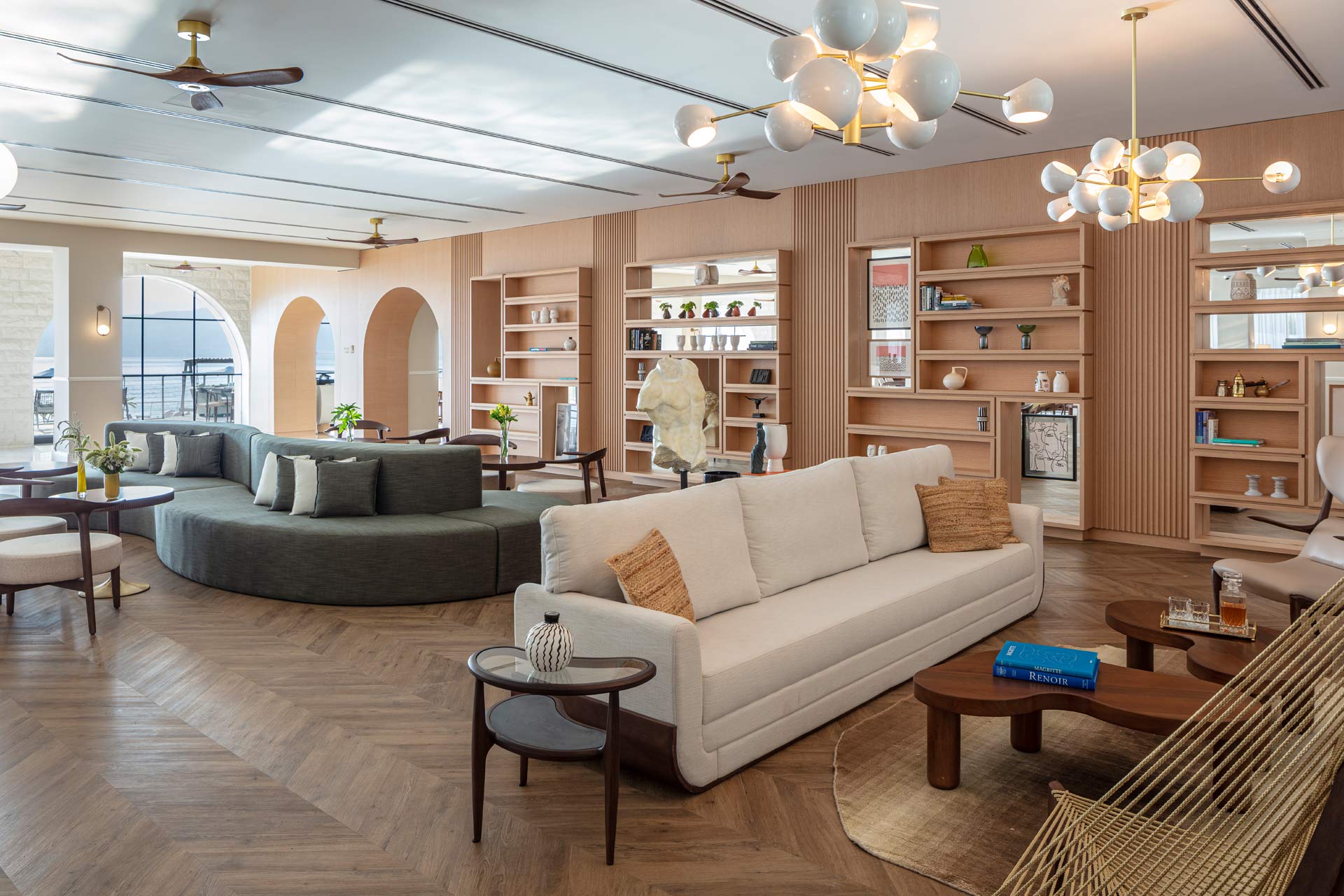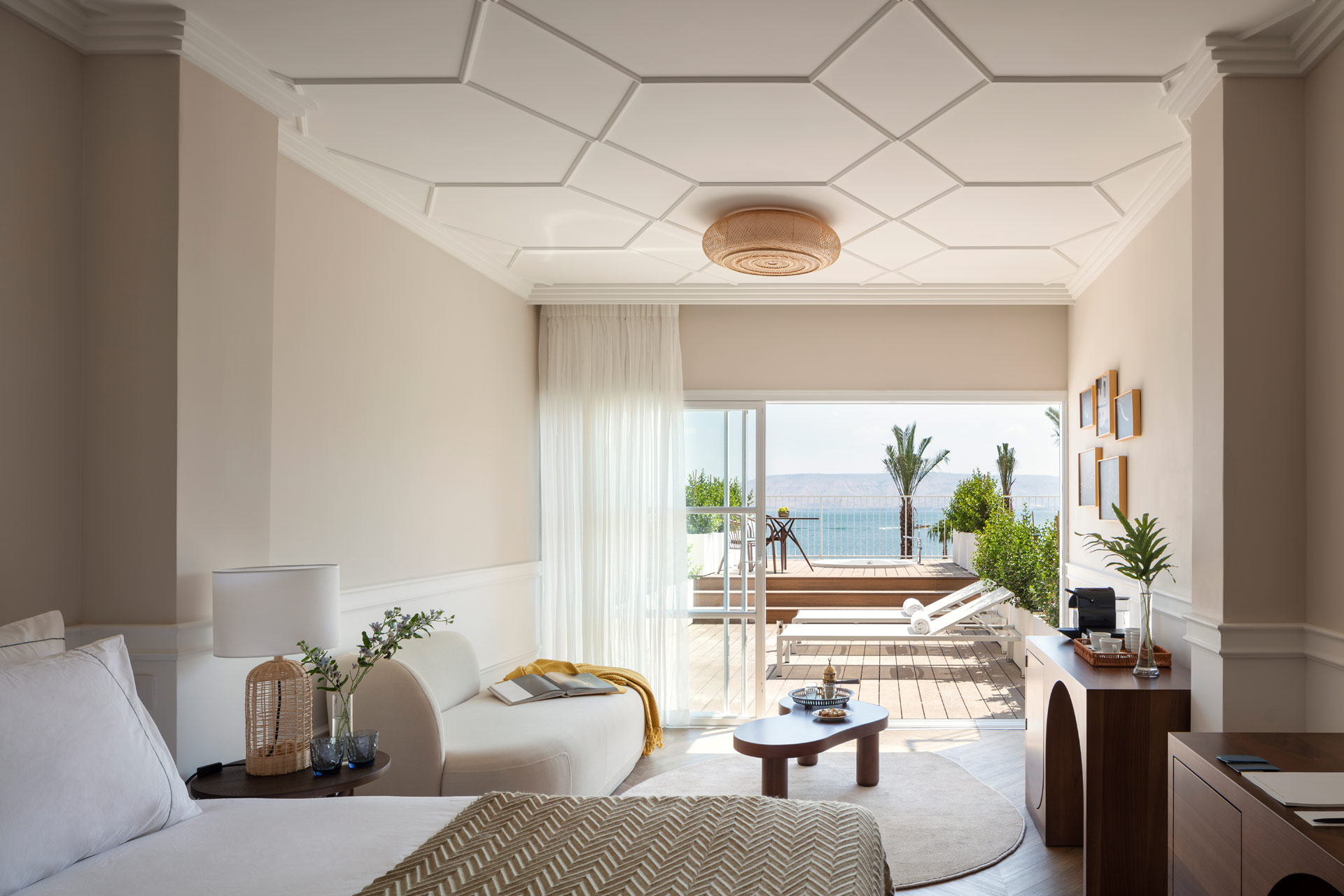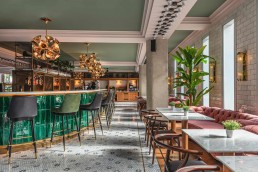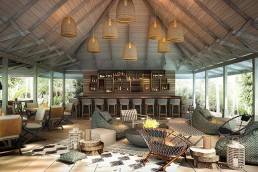London-based design studio Saar Zafrir Design, has unveiled its work on the Galei Kinneret Hotel, a restored 123-room hotel situated on the historical Sea of Galilee in Northern Israel.
Initially built in 1946, the original Galei Kinneret was one of Israel’s first luxury hotels founded by entrepreneur Lotte Eisenberg, inspired by a trip to the magnificent Villa d’Este Hotel in Lake Como. Having been appointed to fully redesign the uninhabited hotel, Saar Zafrir Design has drawn inspiration from the ancient ruins discovered on-site and reworked the charm of Eisenberg’s vision into a seamless design concept that blends the hotel into the natural landscape.

Saar Zafrir has drawn on historical references to determine the narrative of the hotel, which celebrates the property’s long-standing history. Manifesting a clean, white structure, the hotel’s facade has been kept very much the same, while the interior has been transformed into a calm oasis that ushers guests towards the still waters and views across the Sea of Galilee. Emanating a sophisticated and serene atmosphere, the remodelled hotel features a neutral colour palette and the use of natural materials that complement the hotel’s natural surroundings.
The hotel encompasses 123 guestrooms and suites with outdoor hot tubs, presenting either a view of the vast mountainous landscape or Sea of Galilee. Each features parquet wood flooring and off-white panelled walls, with a soothing palette of natural and organic tones. Offering either a view of the mountainous landscape or the Sea of Galilee, the rooms are intended to compliment the hotel’s surroundings for a harmonious experience that connects the guests to nature. The rooms champion the use of natural materials with ample light flooding through large windows and bathrooms finished in pale, veined marble and gold accents.

Upon entering, guests are greeted by a minimal, open space characterised by 3D graphic stone cladded walls, glossy marble flooring and reception desks finished with marble and wood. The foyer was kept clean and quiet, with the intention of the space to draw guests straight through the property, as a corridor to the Sea of Galilee. Championing the use of natural materials and tones, the lobby offers a comfortable lounge area with wood panelled walls, parquet flooring and soft linen upholstered sofas with wooden accents.
Managing the hotel’s restoration from concept to completion, most of the hotel’s fixtures and furnishings have been designed and custom made in-house by Saar Zafrir Design, to perfectly compliment the creative vision.
“I have such fond memories growing up and spending my summers on the Kinneret that despite not generally working in Israel, I couldn’t turn down the opportunity to work on a project that carried so much sentimental value to me,” says Saar Zafrir. “The area has been lacking in attention for some while, but with the relaunch of this iconic hotel, we believe Tiberias will once again become a leading destination for both domestic and international tourists to Israel having set a new standard of hospitality in Northern Israel.”
Through a smooth, cohesive wooden walkway, guests are led from the hotel lobby into the restaurant “Lotte”, named after Eisenberg herself. Presenting a menu honouring Lotte’s European roots merged with the flavours of Jerusalem, Michelin star chef Asaf Granit is the mastermind behind this new culinary concept that captures the spirit of the original founder. The space is vibrantly refined, with organic tones and the use of natural materials featuring parquet wood flooring, wood and rattan fixtures and floral upholstered accents that decorate the space. The main design features are the large archways covered in ceramic tiles in different shades of green, that climb up the walls and across the ceiling like leaves that gently disperse towards the glass wall leading out to the hotel’s private beach.
Overlooking the hotel’s private beach is an outdoor restaurant, swimming pool and cosy outdoor bar. Grounding the hotel to its historic roots, works by Israeli sculpturist Yuval Lufen that manifest the archaeological remains found on the site have been implanted beneath the glass-bottomed swimming pool, with the original ruins currently preserved by the Antiquities Authority in Israel. At the foot of the pool stands a huge tree-like structure by artist Gilad Keinan.
Related Posts
11 October 2021
Saar Zafrir Design channels the 1980s with The ReMIX Hotel
10 February 2021
10 Design to oversee luxury resort in Croatia
25 July 2016



